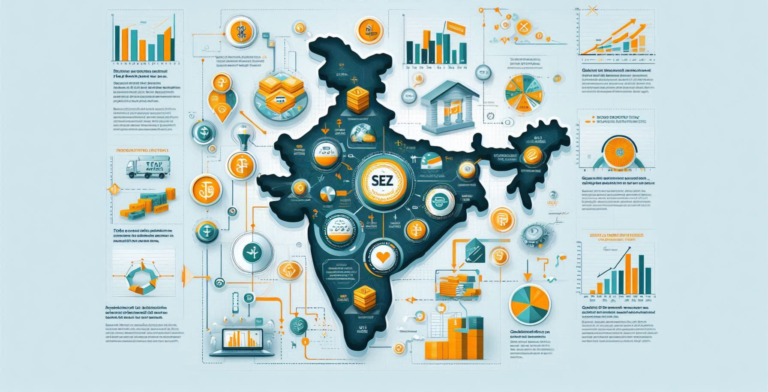
Abstract
India’s Special Economic Zones (SEZs) were established to catalyze economic growth by providing tax incentives to attract investments and boost employment. This analysis examines the current tax incentive framework within Indian SEZs, evaluating its effectiveness in realizing these objectives. While SEZs initially succeeded in drawing investment and promoting industrialization, the study uncovers that the present tax incentives have not consistently resulted in long-term economic benefits or significantly elevated foreign direct investment levels. It highlights the disparities in the application and impact of tax benefits across different sectors and enterprises. The findings suggest a need for a recalibrated approach to tax incentives, proposing reforms such as the introduction of performance-linked tax incentives, increased transparency in policy implementation, and creating a more competitive business environment within SEZs. These reforms aim to ensure a more equitable distribution of tax benefits, better alignment with economic goals, and revitalization of SEZs as robust engines of growth, ultimately contributing more effectively to India’s overarching economic development objectives.
Keywords: Special Economic Zones, Tax benefits, Incentive structure
Hypothesis
The tax incentive structure in Indian Special Economic Zones, while initially effective, requires comprehensive reforms to enhance transparency, equity, and alignment with broader economic goals for sustained long-term growth.
Objective of Study
- In this paper, we shall examine the tax incentive structure in Indian Special Economic Zones (SEZs), focusing on its effectiveness in attracting investment, promoting exports, and generating employment.
- The study will analyze current tax policies, their implementation, and their impact on SEZ businesses.
- It will evaluate the economic outcomes of these incentives, including their contribution to regional development and overall national economic growth. Based on these analyses, the study will propose potential reforms to enhance the effectiveness of the tax incentive structure, addressing any shortcomings or unintended consequences of the current system.
- The ultimate goal is to provide policymakers with evidence-based recommendations for optimizing the tax incentive framework in Indian SEZs.
Research questions
- Whether performance-linked tax incentives impact the competitiveness of SMEs within Indian SEZs?
- Whether SEZ tax incentive structures have a measurable impact on investment-led economic growth in India, and how can policy transparency and administrative efficiency can be enhanced through targeted reforms?
- Whether SEZ tax benefits significantly contribute to India’s sustainable economic development goals, particularly in areas like employment generation, export growth and regional development?
- Whether modifications to SEZ taxes or incentives could better align with Make in India initiatives?
- Whether tax incentives in Indian Special Economic Zones influence corporate investment decisions and operate efficiently, and what reforms could enhance their effectiveness?
Methodology
The paper used the doctrinal method. Information was gathered from sources like statutes, judgments, and legal journals, and then critically analyzed to address legal questions or develop new theories. Our primary sources were Statutes, and our secondary sources were articles, research papers, etc.

Introduction
India’s Special Economic Zones (SEZs) were conceptualized and established with the intent to bolster economic growth, attract foreign investment, and generate employment through a range of tax incentives and conducive policy frameworks1. These zones have been a cornerstone of India’s export-driven growth strategy, modeled after the success stories of similar zones in countries like China2. Over the years, however, the effectiveness of SEZs in India has been a subject of growing debate. Initially heralded as engines of industrialization and economic prosperity, SEZs have encountered a myriad of challenges that have curbed their potential3. This study seeks to critically evaluate the current tax incentive structure within Indian SEZs, to illuminate its strengths and shortcomings, and to propose informed reforms aimed at enhancing their long- term effectiveness4. Tax incentives in SEZs were designed to create an attractive business environment by offering benefits such as income tax exemptions, duty-free imports, and exemptions from various state and local taxes. Despite these incentives, the expected outcomes, particularly in terms of sustained investment growth and substantive contributions to regional development, have been inconsistent5.
Impact of Performance-Linked Tax Incentives on SME Competitiveness in Indian SEZs
Performance-linked tax incentives significantly boost the competitiveness of SMEs within Indian SEZs by reducing operational costs through import duty and GST exemptions and enhancing profitability with income tax benefits on export income6. These financial incentives make SEZs attractive destinations for investment, encouraging both domestic and international companies to set up operations, which fuels growth and innovation. Simplified compliance processes further allow SMEs to focus on their core activities while improving their market position. However, the overall effectiveness is sometimes hampered by complex claim processes and inconsistent policy application7. Balancing these incentives with transparent and stable policies is crucial to maximizing their positive impact on SMEs.
Under GST laws, Special Economic Zones (SEZs) are treated as separate territories to promote exports, as per Section 16 of the IGST Act. Supplies to SEZs are zero-rated, meaning no GST is charged, and suppliers can claim refunds or Input Tax Credit (ITC) on GST paid for inputs. Supplies from SEZs to Domestic Tariff Areas (DTAs) are treated as imports and attract GST, payable by the DTA recipient. Imports into SEZs are exempt from GST and customs duties, while transactions within SEZs are GST-free. These provisions simplify compliance, reduce costs, and support export growth.8
SEZ Tax Incentives and Investment-Led Economic Growth in India, aligning with Make in India Initiatives
SEZs in India offer a host of benefits, including duty-free import procurement, 100% income tax exemptions on export income for the initial 5 years and 50% for the next 5 years and 50% of the export profits reinvested into the business will be eligible for benefits or incentives for the next five years9. These benefits are mentioned under the Income Tax Act Section 10AA10 These exemptions on taxes attract investments towards India to boost its overall economy. Timely reforms like the integration of Aatma Nirbhar Bharat could help the industries Small and medium industries that have been contributing internally which was widely appreciated by the industrialists as they could also expand their market and collaborate and compete with the big giants or at the global market.11
Under GST laws, Special Economic Zones (SEZs) are treated as distinct territories to encourage exports with tax relief and simplified compliance. Supplies to SEZs are zero-rated, meaning no GST is charged, and suppliers can either use a Letter of Undertaking (LUT) to avoid GST or pay IGST upfront and later claim a refund. Supplies from SEZs to Domestic Tariff Areas (DTA) are considered imports, attracting GST, which the DTA recipient pays under the Reverse Charge Mechanism (RCM). Goods or services imported into SEZs for authorized operations are exempt from GST and customs duties. Transactions within SEZs are GST-exempt, while supplies between SEZs follow inter-state GST rules. Compliance includes submitting LUTs, issuing GST-compliant invoices, and filing GSTR-1 for zero-rated supplies. These provisions are outlined in Section 16 of the IGST Act, Rule 89 of CGST Rules, and the SEZ Act, 2005, supporting cost-effective operations and export growth.12
To fully leverage the benefits of SEZ tax incentives, it is crucial to align SEZ policies with the objectives of the ‘Make in India’ initiative. This can be achieved by streamlining regulatory procedures to simplify the establishment and operation of manufacturing units within SEZs, ensuring policy stability and clarity to foster investor confidence, and enhancing infrastructure and connectivity to support efficient production and distribution networks. By integrating these measures, India can bolster its manufacturing sector, reduce dependence on imports, and position itself as a competitive global manufacturing hub.13
Evaluating the Influence of Tax Incentives in Indian Special Economic Zones on Corporate Investment Decisions and Operational Efficiency: Pathways or Reforms
As discussed earlier, incentives have made SEZs attractive for export oriented businesses, especially in manufacturing and IT services. Companies benefit from reduced input costs due to customs and excise exemptions, and streamlined foreign exchange operations further enhance global competitiveness14
However, the effectiveness of these incentives is often undermined by regulatory complexity, sunset clauses, and compliance burdens. Many investors face legal and procedural hurdles that dilute the intended benefits15. To improve corporate impact, reforms could include extending the sunset clause for tax exemptions, simplifying the compliance procedures, enhancing the transparency in regulatory audits, offering sector specific incentives aligned with national priorities. Such reforms would not only sustain corporate interests in SEZs but also align them more closely with India’s long term economic goals.

SEZ Tax benefits and India’s Sustainable Economic Development goals
SEZs drive sustainable growth by fostering industrial practices that align with environmental norms through tax exemptions and infrastructure support. With a focus on energy-efficient and clean technology, SEZs can lead India’s transition to a green economy. The balance lies in ensuring rigorous environmental policies while providing fiscal benefits to encourage investment16.
SEZs are also equipped with advanced infrastructure, including green buildings, waste management systems, and renewable energy sources, which align with India’s commitment to global sustainability goals. By focusing on sectors like renewable energy production, electric vehicles, and recycling industries, SEZs can act as hubs for innovation in the green economy.
Incentivizing Corporate Social Responsibility (CSR): Many SEZs are focusing on Corporate Social Responsibility (CSR) initiatives aimed at environmental sustainability, including afforestation projects, waste management, and water conservation. The tax benefits provided by Section 10AA of the Income Tax Act can indirectly support these CSR initiatives by freeing up funds that can be redirected to socially and environmentally responsible activities.17
Conclusion
India’s SEZ framework has been instrumental in driving exports, attracting investments, and generating employment. However, to ensure sustained growth and alignment with initiatives like ‘Make in India’ and sustainable development goals, reforms are needed. Introducing performance-linked tax incentives, streamlining regulatory procedures, and enhancing policy transparency can improve efficiency and investor confidence. Promoting green practices through investments in renewable energy and waste management, along with tailored support for SMEs, can further boost SEZ competitiveness. Additionally, fostering regional equity, integrating SEZ policies with national programs, and incentivizing CSR activities can enhance the socio-economic and environmental impact of SEZs, transforming them into engines of inclusive and sustainable development.
References
https://byjus.com/free-ias-prep/special-economic-zone/?form=MG0AV3.
https://unctad.org/system/files/official-document/diaeinf2023d1_en.pdf?form=MG0AV3.
https://www.impriindia.com/insights/desh-sez-amendment-bill/?form=MG0AV3.
https://blog.tatanexarc.com/msme/sez-special-economic-zone-under-gst
https://blog.tatanexarc.com/msme/section-16-of-cgst-act
https://ebooks.inflibnet.ac.in/mgmtp08/chapter/special-economic-zones/?form=MG0AV3.
www.ahlawatassociates.com/blog/india-sezs-tax-incentives-regulatory
Footnotes
- Facilities and Incentives, Special Economic Zones in India ↩︎
- Special Economic Zone (SEZ), What are SEZs? Advantages of SEZs, etc ↩︎
- The Impact of International Tax Reforms on Special Economic Zones ↩︎
- Rawat A., From DESH to the SEZ Amendment Bill (2024): Another Attempt at Revamping SEZ’s?, Impact
and Policy Research Institute ↩︎ - Ibid 1 ↩︎
- T. Suyanshi In, (2024). SEZs – The tax implications with regards to SEZs ↩︎
- Anirban Sinha, SEZ in GST: Full Form, Tax Benefits, Rules, and Compliance Guide ↩︎
- Anirban Sinha, Section 16 of CGST Act: Eligibility and conditions for ITC ↩︎
- Ibid 1 ↩︎
- The Role of Section 10AA of the Income Tax Act in Promoting Sustainable Growth for Indian SEZs ↩︎
- B. Sapra, (2022). A new and vibrant SEZ policy to boost Atmanirbhar Bharat campaign ↩︎
- Ibid 7 ↩︎
- The benefits of manufacturing in India: tax benefits and subsidies ↩︎
- Ahlawat (2025). [Online]. Ahlawat and Associates. ↩︎
- Ibid 14 ↩︎
- Arora M., Special Economic Zones – International Business Operations ↩︎
- Ibid 10 ↩︎




